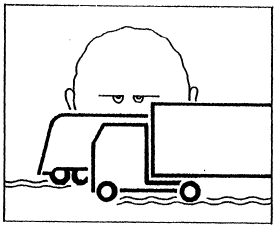
Effective control of the undesirable effects of highway generated noise requires a three-part approach:
The first two components are currently being addressed by private industry and by Federal and state agencies. The third area is traditionally an area of local governmental responsibility.
Cooperation among all levels of government, industry and the public in implementing the three-part approach is essential to achieving noise reduction, because of the limitations of each noise control approach when applied separately.
Source emission reduction requires the development of quieter cars and trucks. Significant progress is being made in research to reduce vehicle engine and exhaust noise, but tire design, the major source of high speed traffic noise, may place limits on further improvements.
Improved highway design involves greater attention to noise impacts in choosing the route and layout of new highways. In April 1972, the Federal Highway Administration issued standards for highway noise levels in its Policy and Procedure Memorandum PPM 90-2, “Noise Standards and Procedures.” These standards are not a complete solution to highway noise, but “represent a balancing of that which may be desirable and that which may be achieved.” PPM 90-2 urges highway agencies to strive for even lower noise levels where they can “be achieved at reasonable cost, without undue difficulty, and where the benefits appear to clearly outweigh the costs and effort required.” PPM 90-2 requires consideration of noise abatement measures for developed areas near new highways, but does not regulate noise in undeveloped areas, or along existing roads. Rather, it recognizes a dual responsibility where “Highway agencies have the responsibility for taking measures that are prudent and feasible to assure that the location and design of highways are compatible with existing land use. Local governments, on the other hand, have responsibility for land development control and zoning.”
Thus, land use control will continue to be a crucial component of the three-part approach to noise control. Local governments will continue to have the responsibility for discouraging the development of noise sensitive land uses (such as homes and schools) in highway noise impacted areas or for ensuring that any such development that does occur is planned to minimize the adverse effects of noise.
The Federal Highway Administration commissioned the development of this manual to assist local government officials in dealing with the problems of noise-sensitive land uses. Its purpose is three-fold:
The manual does not attempt to present a single strategy for achieving noise compatibility, but recognizes that solutions to noise problems will depend on local conditions and community preferences. Therefore, a wide variety of potential techniques are presented and their applicability to differing local conditions evaluated. A summary of these solutions is presented in Section 2. Detailed descriptions of techniques available to local government officials to encourage noise compatible development are presented in Section 3. Section 4 describes methods which can be used by architects, developers and builders to achieve noise impact reductions. Section 5 outlines possible strategies for local governments to implement a noise compatible land use program, and describes some of the potential obstacles and further sources of information.
An Appendix describes three case studies of the applicability of the approach of this manual to the highway noise problems of local communities. A second Appendix reviews the noise measures and noise standards referred to in the manual.